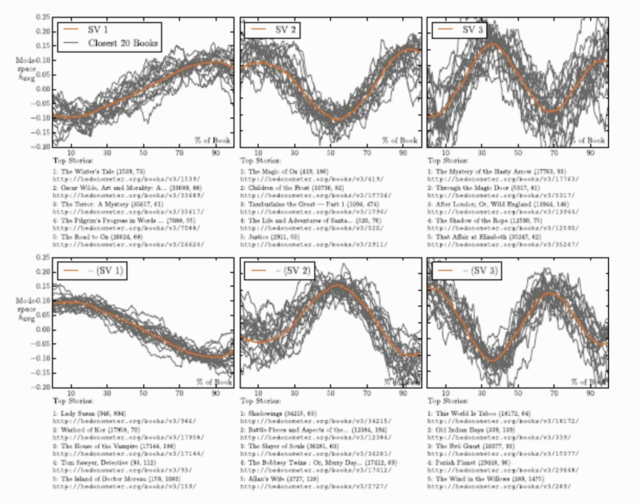Social Learning Theory
Why Are So Many Movies Basically the Same?
People may like them because they produce evolved pleasurable responses.
Posted July 12, 2021 Reviewed by Ekua Hagan
Key points
- An analysis of 1700 books found that most follow just one of six emotional story arcs.
- A recent paper argues we like certain stories because they activate evolved cognitive mechanisms.
- People are interested in stories involving overcoming obstacles because they evolved to learn from others.
- People derive pleasure from seeing (fictional) others succeed, a mechanism that likely helped to promote cooperation.

What do Star Wars and Harry Potter have in common? In addition to having their own theme parks, quite a lot. Both feature orphaned protagonists who discover they have special powers and eventually go on to save the world. In fact, both stories follow a common template that can be found repeatedly in fiction, known as "the hero's journey" or the monomyth.
In a previous post, I wrote about how true originality in creative work is rare. But what draws us to the same basic stories over and over again? Two recent journal articles offer a possible answer.
There are only about six basic stories
The first, published in 2016 by a group of researchers led by Andrew Reagan at the University of Vermont, analyzed about 1700 books downloaded from Project Gutenberg. The researchers used an AI method called sentiment analysis that assigns an estimate of the emotion expressed in a section of text. For example, the sentence "I'm super excited about my birthday tomorrow!" would be classified as highly positive. They constructed sentiment profiles of each book from start to finish to get a rough sense of their emotional arcs: Do they start happy and end sad, start sad and end happy, or something else? Then they used some statistical methods to see how many different profiles could be found in the set of books.
Most books fell into six basic categories, which they called:
- Rags to riches (start sad, end happy)
- Tragedy (start happy, end sad)
- Man in a hole (start happy, get sad, end happy)
- Icarus (start sad, get happy, end sad)
- Cinderella (start sad, get happy, get sad, end happy)
- Oedipus (start happy, get sad, get happy, end sad)

Somewhat surprisingly, even though rags to riches and tragedy stories were most common, man in a hole, Icarus, and Oedipus stories were slightly more popular, based on download numbers.
This study supports the idea that most stories are, at their core, pretty much the same. But it doesn't explain why that is, or why people prefer certain types of stories. There's no reason why someone couldn't write a riches to riches story in which everyone is happy from beginning to end, but it seems intuitively obvious that that story would be pretty boring.
A new theory argues we were born to like certain stories
An article published this month by anthropologist Manvir Singh argues that what makes stories like Star Wars and Harry Potter so appealing is what Singh calls their "sympathetic plots."
The sympathetic plot, which is shared by countless stories across cultures, has several core features that are not unlike those of the hero’s journey: A hero has a justifiable goal, faces an obstacle, overcomes it, and earns a reward for themselves or for others.
Singh argues that the reason sympathetic plots are so appealing is that they hijack evolutionarily developed mechanisms for social learning. One of the most valuable skills humans have that distinguishes us from other animals is the ability to learn from others: Rather than having to figure out how to fix a running toilet on your own, you can watch a couple of other people do it on YouTube and you're pretty much up to speed. As a result, Singh argues, we're fascinated when we see people encounter obstacles, and we feel some pleasure when we learn how they overcame them. Of course, learning how Luke Skywalker destroyed the Death Star is completely useless knowledge for us, but this social learning mechanism is so deeply ingrained, watching him do it produces the same pleasure response.
Consider an alternative explanation for why we like fiction: It allows us to put ourselves in the roles of the protagonists to simulate solving similar problems. But again, we'll never need to know how to use The Force or fight goblins. Instead, Singh argues that the pleasure we experience hearing these stories is just a side effect of our interest in learning how people overcome obstacles in general, even fictional ones.
We're happy when people we like succeed
Another relevant mechanism is what Singh calls "sympathetic joy": We feel happy when others succeed. Some researchers believe that sympathetic joy evolved to help motivate cooperation: If helping others succeed will make you feel good, this ought to motivate you to help people and vice versa.
These two mechanisms can help explain why a riches to riches story would be so boring: no obstacles to overcome, no success to be had. In other words, it would fail to activate either mechanism.
What about tragic endings?
But not all popular stories follow the sympathetic plot template. Recall that some of the most popular story arcs identified in the analysis of Project Gutenberg books ended in tragedy (so-called Icarus and Oedipus stories). Stories like these would, at the very least, seem to fail to activate any sympathetic joy.
As Singh points out, these evolutionary mechanisms are not the only factors that affect how enjoyable a story is. People may be drawn to how thought-provoking a story is, whether it was written or filmed in a unique way, or whether the ending, while tragic, provided some sort of closure. That is, the existence of the social learning and sympathetic joy mechanisms can explain why so many stories are so similar, but their existence doesn't mean that every story in history will conform to the sympathetic plot.
None of this of course means that you can write an award-winning novel by following a simple formula (as if rags to riches or "overcoming obstacles" are helpful formulas anyway). Instead, these articles suggest that successful writers have converged on a common storytelling structure that they fill with rich and compelling characters, events, and relationships. As I argued in my earlier post, it doesn't really matter when we see something familiar in a new way because it can still be enjoyable. Clearly, this is true: People have been consuming essentially the same stories for hundreds of years.
References
Reagan, A.J., Mitchell, L., Kiley, D. et al. (2016). The emotional arcs of stories are dominated by six basic shapes. EPJ Data Sci., 5, 31.
Singh M. (2021). The Sympathetic Plot, Its Psychological Origins, and Implications for the Evolution of Fiction. Emotion Review, 13(3), 183-198.




